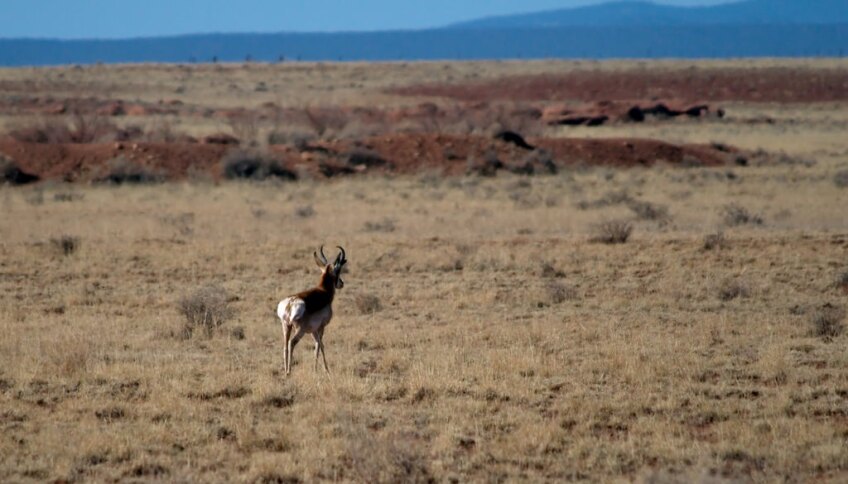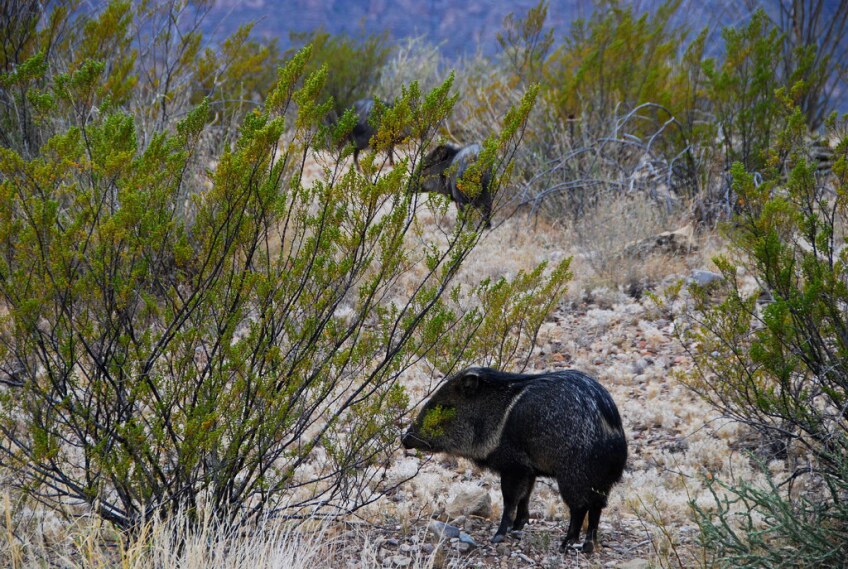Trump's Border Wall Would Be a Disaster for Wildlife


California's border with Baja California is a complex region with unique environmental issues. Our Borderlands series takes a deeper look at this region unified by shared landscapes and friendship, and divided by international politics.
A female arroyo toad shelters under a streamside cottonwood in early March, twenty years from now. It's unseasonably warm, and there's something ancient stirring inside her. She listens. A male is singing. She finds his song beautiful. Everything in her wants to follow that sound, to find the male and mate with him. She would release her eggs for him to fertilize. Those eggs would grow in long submerged strings, until a new generation of arroyo tadpoles hatched from them a week later. Her drive to find that male is irresistable. But she cannot reach him.
A month and a half later, three hundred miles east, a small group of javelinas cools its collective heels in the shade of an ironwood tree. The engaging, pig-like beasts are hungry. A couple of them root in the soil of the wash, looking for tubers. Not far away, a mesquite hangs heavy with last year's crop of pods. The javelinas can smell those pods, even after a season of drying on the branch. The one tree could feed the entire pack for two days, and the javelinas would disperse a few of the seeds elsewhere to make new mesquites. But that's not going to happen. There's something in the way.
In July, wild eyes scan and a pair of slitted nostrils sift the desert breeze. The jaguar finds no good news in the air. He curls back his upper lip and tries again, head held high. He's not looking for food. Here in the Patagonia Mountains of southern Arizona, game is plentiful enough to keep his ribs well hidden. It's plentiful enough, in fact, to support a few more jaguars, to provide a launch pad for North America's largest wild cat to reinhabit the southern Rocky Mountains. But that would require the cooperation of one or more female jaguars. And thanks to a project propelled by destructive politics and fear, there won't be any lady jaguars in the Patagonia Mountains anytime soon.
In previous articles in this series we've looked at a some of the likely unintended environmental consequences of the gigantic border wall proposed by Republican Presidential candidate Donald Trump, from the climate impacts of such a massive construction project to the wall's inevitable disruption of stream courses resulting in massive floods.
But some of the longest-lasting environmental consequences of the proposed border wall would result from the wall doing precisely what it's supposed to do: stop migration across the border. The wall will impede a lot more than just human beings from migrating. It will stop animals as well, and their genes, and even the plant species they disperse.

If you're wondering how a wall would prevent plants from migrating, consider those hypothetical javelinas in the spring of 2036, wistfully regarding those mesquite pods from across the international boundary wall. Javelinas, a distant cousin of domestic swine, play a very important role in moving plant species such as cacti and leguminous desert trees from place to place. When a javelina gobbles up seed-packed fruits, then excretes the seeds some distance away, it's taking part in the age-old process of plant migration. Without aid from dispersing animals like the fruit-eating javelinas, many plants wouldn't be able to scatter their progeny to potentially hospitable spots in the landscape.
That's especially important as the planet warms, and habitats north of the border become better places for southern plants to live. During past periods of climate change, the earth's plants have either found ways to move their progeny to more suitable new habitats, or they've died out.
As we've written in previous articles on the proposed border wall, actual specifics about that wall's dimensions are hard to come by. But if the loose talk about a border wall more than 50 feet tall comes to fruition, it won't just be plants that depend on javelinas that suffer. A wall that tall will block even many wind-borne seeds, and fruits dispersed by ground-dwelling birds like the Gambel's quail that prefer not to fly that high if they can avoid it.

The border wall would also impede the migration of genetic material, which is as important for long-term biodiversity health as the migration of individual animals. That's true even for animals that don't spend a lot of time moving around, such as arroyo toads. An individual toad may not move more than a mile in her lifetime, except by accident. But arroyo toad genes move back and forth across the landscape as successive generations of new toads mate with toads on the edges of their home territory, and the resulting offspring mate with toads even farther away.
Put a 50-foot barrier across arroyo toad habitat and that gene flow stops. Again, in a warming world in which southern toads may possess genetic tolerance of higher temperatures, cutting off the flow of genes from south to north is especially counterproductive.
And then, of course, there's the kind of migration most of us are more likely to picture in the context of the proposed border wall: big animals seeking out new territory, or trying to migrate with the seasons, that come upon an impassible barrier. And the borderlands shared by the U.S. and Mexico have a lot of embattled big animals that don't need any more obstacles to migration than they've already got. The borderlands are a zoological wonderland with unique charismatic megafauna. Those jaguars trying to get to Arizona, for instance, have company: five of North America's six species of big cats live around the border. Sonoran pronghorns, a subspecies of the second-fastest land mammal in the world, cruise the grasslands on either side of the border. The endangered Mexican wolf, the subject of an expensive reintroduction program, does better when it can roam where it will. The Peninsular bighorn sheep, whose range includes both California and northern Baja California, is still able to migrate across the border because of a break in the existing fence between Jacumba, California and La Rumorosa just across the border. A wall would be catastrophic for the Endangered sheep.
We know Donald Trump's border wall will be a problem for wildlife, in fact, because there's already a border "wall," in places made of sheet steel, in other places a formidable fence. Its construction, which started in 2007 was granted exemption from a wide range of federal environmental laws, including the Endangered Species Act. As explained in the short documentary film "Think Like A Scientist: Boundaries," that wall has already had a definite impact on wildlife, even though it's not nearly as impassable a barrier as the proposed wall would be. Have a look:
Think Like A Scientist: Boundaries | Credit: Day's Edge Productions, used with permission.
We have a tendency to think of ecosystems — when we do think of ecosystems — as static collections of different animals, plants, and other organisms that interact in certain predictable and stable ways. That's sometimes true. But ecosystems are much more than that. Even if there aren't rivers running through them, ecosystems are characterized by immense and shifting currents of resources, of individual animals, of gene pools, of species and relationships between those species.
It's not that natural ecosystems don't possess barriers to that flow. Habitats have all kinds of boundaries in them, whether you're talking about rivers too deep to walk across or cliffs too steep to crawl, frigid mountaintops and sweltering valleys, or even just a place where you can't roam because that other jaguar lives there and resents your presence.
But those natural barriers tend to be limited. They're usually gradual, and shifting, and they often provide opportunities for wildlife rather than obstacles — like an verge between forest and grassland that's home to more wildlife than the habitats on either side of it. And natural barriers don't affect all wildlife the same way. A sunny, desiccated granite cliff that serves as an impassable barrier an arroyo toad may be ideal habitat for a lizard.
The border wall, and the fence that has preceded it, are different. Borderlands wildlife hasn't had a chance to evolve adaptations to the wall, which will appear in an evolutionary eyeblink in a landscape already dying from a thousand human-made cuts. Those Peninsular bighorn may be able to get through the break in the fence at Jacumba, but they have trouble with Mexico's Route 2 just south of the fence. Only a few are willing to cross the high-speed highway. The wall would keep even those more intrepid sheep from moving back and forth as they see fit.

The worst thing about the wall's likely wildlife impacts is that they're completely unnecessary. Even if you feel that the human rights crisis involved in international migration is best addressed by sealing the border, there are other ways to do just that, with cameras and other mid-range surveillance equipment, that won't affect so much as a single hungry javelina.
But of course the humane answer to border crossing isn't to seal the border. The United States has tried to fortify the border for the last two decades with little success. Hardening the easy points of entry has merely pushed desperate migrants into the desert, where they face serious danger just from the elements, as well as from the unscrupulous people who profit from "helping" them cross.
Turning the existing border fence into an even more formidable 50-foot wall won't stem the flow of people, as long as there are 51-foot ladders in the world. But it will be catastrophic for wildlife. And as the whole wall proposal is driven by the cynical use of fear to gain political leverage, we just don't need to cause that damage. Residents of the borderlands tend to agree: a humane border policy that treats our neighbors as neighbors, rather than an invading army, would make us a better citizenry.
And it would certainly be better for the wildlife whose borderlands we share.
Banner photo: Krista Schlyer, taken as still from the video Think Like A Scientist: Boundaries via Day's Edge Productions